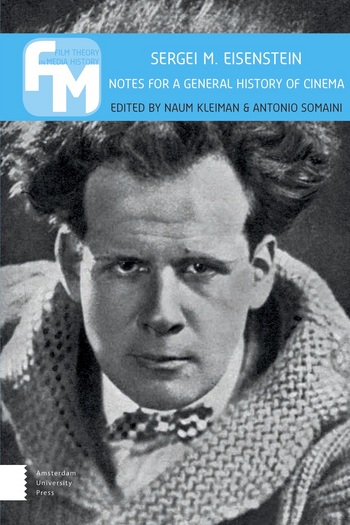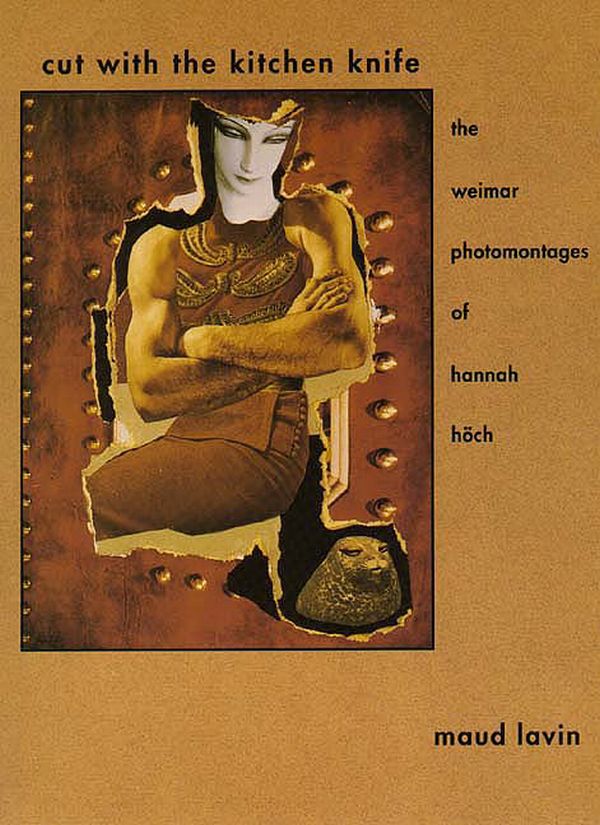Sergei M. Eisenstein: Notes for a General History of Cinema (2016)
Filed under book | Tags: · cinema, film, film history, film theory, media archeology, montage

“This comprehensive volume of Eisenstein’s writings is the first-ever English-language edition of his newly discovered notes for a general history of the cinema, a project he undertook in 1946-47 before his death in 1948. In his writings, Eisenstein presents the main coordinates of a history of the cinema without mentioning specific directors or films: what we find instead is a vast genealogy of all the media and of all the art forms that have preceded cinema’s birth and accompanied the first decades of its history, exploring the same expressive possibilities that cinema has explored and responding to the same, deeply rooted, “urges” cinema has responded to. Cinema appears here as the heir of a very long tradition that includes death masks, ritual processions, wax museums, diorama and panorama, and as a medium in constant transformation, that far from being locked in a stable form continues to redefine itself.
The texts by Eisenstein are accompanied by a series of critical essays written by some of the world’s most qualified Eisenstein scholars.”
Edited by Naum Kleiman and Antonio Somaini
Publisher Amsterdam University Press, Amsterdam, 2016
Creative Commons BY-NC-ND 3.0
ISBN 9789048517114
545 pages
Craig Buckley: Graphic Apparatuses: Architecture, Media, and the Reinvention of Assembly 1956-1973 (2013)
Filed under thesis | Tags: · architecture, assembly, collage, history of architecture, machine, media, montage
“This study examines the work of a number of architects who sought to rethink the physical, visual, and historiographic problems of assembly at a moment when the discipline was being destabilized by changing cultural politics and the proliferation of new electronic media.
Through a series of case studies, it analyzes buildings, images, publications, prototypes, and films made from the late 1950s to the early 1970s by architects in London (Theo Crosby and Edward Wright), Vienna (Hans Hollein, Gunther Feuerstein, Walter Pichler), Paris (the Utopie group), and Florence (the Superstudio group).
I argue that during these years the making of composite images was intensely identified with imagining new forms of construction, a dynamic informed by concepts of montage pioneered by the historical avant-gardes. Rather than compare postwar experiments to those of the 1920s, the dissertation considers how emerging media practices responded to the absorption of montage into postwar mass culture. The rethinking of montage paralleled a changing attitude toward machines, in which an earlier 20th-century ambition to master mechanization through design and prefabrication gave way to an attitude emphasizing a more flexible combination and rearrangement of parts, materials, and concepts drawn from a wide range of sources. Assembling an image out of disparate photomechanical elements graphically enacted the manner in which architects imagined appropriating technologies and materials from outside the domain of architecture in a bid to transform the discipline. During these years architects engaged montage as a mode of working both within and against the space of architectural publicity; one that was less illustrative than it was performative.
If efforts to reinvent problems of assembly aimed to shift discourse within the discipline, they were also shaped by changes in the technological apparatuses of mechanical reproduction, notably the displacement of industrial letterpress by photo-offset lithography. In retrospect, grasping changing ideas of assembly helps to comprehend how during these years the status of building shifted within architectural culture, while also prefiguring how habits of “cut and paste,”–the continual combination and alteration of ready-made visual material–would become central to the operational culture of digital tools in our own time.”
Publisher Architecture Department, Princeton University, 2013
Advisors: Beatriz Colomina and Spyros Papapetros
316 pages
PDF (12 MB)
Comment (0)Maud Lavin: Cut With the Kitchen Knife: The Weimar Photomontages of Hannah Höch (1993)
Filed under book | Tags: · art, art history, avant-garde, collage, dada, gender, mass media, montage, photomontage, weimar republic, women

“The women of Weimar Germany had an uneasy alliance with modernity: while they experienced cultural liberation after World War I, these “New Women” still faced restrictions in their earning power, political participation, and reproductive freedom. Images of women in newspapers, films, magazines, and fine art of the 1920s reflected their ambiguous social role, for the women who were pictured working in factories, wearing androgynous fashions, or enjoying urban nightlife seemed to be at once empowered and ornamental, both consumers and products of the new culture. In this book Maud Lavin investigates the multi-layered social construction of femininity in the mass culture of Weimar Germany, focusing on the intriguing photomontages of the avant-garde artist Hannah Höch.
Höch, a member of the Berlin Dada group, was recognized as one of the most innovative practitioners of photomontage. In such works as Dada-Ernst and Cut with the Kitchen Knife, she reconstructed the wonderfully seductive mass media images of the New Woman with their appeal intact but with their contours fractured in order to expose the contradictions of the new female stereotypes. Her photomontages exhibit a disturbing tension between pleasure and anger, confidence and anxiety. In Weimar—as today—says Lavin, the representation of women in the mass media took on a political meaning when it challenged the distribution of power in society. Höch’s work provides important evidence of the necessity for women to shape the production and reception of the images that redefine their role.”
Publisher Yale University Press, 1993
ISBN 0300047665, 9780300047660
xvii+260 pages
Reviews: Johanna Drucker (Art Journal 1993), Susan Sensemann (Design Issues 1994), Greil Marcus (2014).
PDF (assembled from scans on author’s Academia.edu page, 24 MB, no OCR)
Comment (0)
